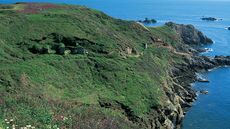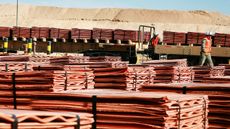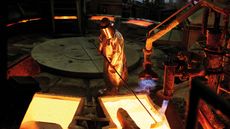How to profit from the mundane metals miners
A decade-long mining boom has ended. A lack of discoveries today means a shortfall – and price rises – tomorrow. Zinc and lead may not seem thrilling, but Dominic Frisby is getting excited.


A decade-long mining boom has ended. A lack of discoveries today means a shortfall and price rises tomorrow. Zinc and lead may not seem thrilling, but Dominic Frisby is getting excited.
Zinc isn't an exciting metal. It doesn't have the politics of gold, the allure of platinum, the controversy of uranium, the new-tech potential of lithium, the "one-day Rodney" dream of silver, the exotic quality of some little-known metal ending in "-ium", or the market share of copper. It's just zinc. The only metal that's less enticing is probably lead. No surprise that the two usually occur together. But dull as they may be, I'm excited about both of them.
Zinc is the fourth most widely used metal in the world, after iron, copper and aluminium. The market for zinc is worth around $38bn a year. To put that in some perspective, it's maybe double the size of the silver market, and about a fifth of the size of the copper market. Zinc's main use is in construction. The frames of buildings, bridges, roofs, staircases, beams and piping all contain zinc a quick coat of the stuff over iron or steel will protect the metal beneath from rusting. It's used in alloys (brass and bronze) and in compounds with a range of applications, particularly in batteries from ordinary AAs to the silver-zinc batteries used in aerospace. It is also increasingly used in fertiliser.
Subscribe to MoneyWeek
Subscribe to MoneyWeek today and get your first six magazine issues absolutely FREE

Sign up to Money Morning
Don't miss the latest investment and personal finances news, market analysis, plus money-saving tips with our free twice-daily newsletter
Don't miss the latest investment and personal finances news, market analysis, plus money-saving tips with our free twice-daily newsletter
Lead, meanwhile, is an about $15bn market. Around 85% goes into making lead acid batteries for motor vehicles. These batteries are also the mainstay of storage technologies for renewable energy sources, such as solar cells; and back-up power supplies for key buildings such as hospitals. Rolled lead is also used in flashing, roofing and cladding for buildings, while its density and resistance to corrosion mean it's also used as lining in chemical treatment baths and acid plants, and as protection against radiation in hospitals, dental surgeries, and nuclear plants, among other things.
Several factors are making me bullish on these metals right now zinc in particular. In 2011, the decade-long mining boom came to an end. The resulting mining recession crippled the industry. Existing mines were shut down, development projects were halted, and exploration budgets evaporated. Major miners just stopped spending on exploration altogether, while investors abandoned the small- and mid-cap mining stocks. And who can blame them?
Any discoveries that were made were given no value at all in the market. But a lack of discoveries today means shortfalls tomorrow or in good time, at least. In 2016, things finally took a turn for the better. The zinc price rose by about 60%. Lead's gains were more muted at one stage it had risen by more than 30%, but it ended the year up about 10%. Both have since pulled back a little.
The pending shortages of lead and zinc
But how long can that last? In recent years, the trend has been for lead and zinc mines to close. In China, many mines (26 in 2015/16) have been closed for environmental reasons. Elsewhere the problem is depletion. Notable recent closures include Lisheen in Ireland, Century in Australia which between them accounted for around 5% of global supply and Glencore Xstrata's Perseverance and Brunswick mines. This now seems to have levelled off, and lead-mine supply is actually set to rise by 12.7% this year, mostly thanks to rising Chinese output (China is both the largest producer and consumer). Zinc mine production is also set to rise by 6.3%, mainly due to growth in Eritrea, India, Peru and Turkey, which outbalances closures in Australia and the US.
Nevertheless, provisional 2017 data from the International Lead and Zinc Study Group shows that 91,000 more tonnes of lead will be used than will be produced this year. In 2016, the deficit was a lot smaller, at 25,000 tonnes. Demand has risen by 23% in the US and 13% in China, with average global demand up by 10.3%. Zinc, meanwhile, is showing a much larger deficit perhaps as much as a million tonnes this year. China accounts for almost half of annual zinc demand. It is the world's largest producer, contributing between 35% and 40% of global supply. Yet it is a net importer, with Chinese imports expected to rise by 28% on the same period last year. US demand is set to grow by 19%.
As a result, stockpiles of both zinc and lead are falling. London Metal Exchange (LME) zinc stocks, at near 270,000 tonnes, are down 37% this year, and more than 75% lower than their 2013 highs. And they keep falling. They have only been this low twice in the last 20 years once in 2001 and once in 2008, during the financial crisis. Bull markets followed both times. According to metals analyst Kaynat Chainwala, cancelled warrants (stocks earmarked for delivery) on the LME stand at 70%, indicating tightness in supplies of the metal. Shanghai stocks are also tight, down by 50% to near 78,000 tonnes.
Lead stocks at 160,000 tonnes are low too, though not as compellingly low as those of zinc (at one stage in 2008 there was barely 200 tonnes of lead). The trend may not be as clear as that of zinc, but it is falling nonetheless. And don't expect supply to catch up soon mining research analyst BMI expects lead production to be flat or to rise by about 1% over the next five years. Zinc production is projected to be slightly higher on 2% growth.
This all boils down to two questions. Where do industrial metals go from here? Can we expect big infrastructure spends from China and the US in the years ahead? Also consider the fact that industrial metals are seen as "late-cycle" assets they do well towards the end of a stockmarket cycle. Given that the bull market has gone on since 2009, you could argue that this is indeed where we are. Industrial and precious metals, as well as energy, have been the laggards. Perhaps it is their turn to soar.
The best ways to invest
There are a range of ways to play lead and zinc. There are exchange-traded funds (ETFs), which track the prices. ETF Securities offers London-listed ETFs under the tickers ZINC and LEED.An alternative arguably less volatile option (although only relatively) is to invest in the large miners. BHP Billiton (LSE: BLT) is the world's largest producer of zinc, while other options include Anglo-American (LSE: AAL), Vedanta (LSE: VED) and KAZ Minerals (LSE: KAZ), although none are pure plays they all produce other metals.
Instead, I prefer small and tiny-cap exploration and development plays. These are highly speculative and very risky. But I reckon the need for new mines means these stocks are where the money will be made. The stocks I mention below are all listed either in the US or in Canada, so you will need a broker if you want to buy in. (Disclosure: I own shares in all of them.)
First there's dual-listed Solitario Zinc (NYSE: XPL; Toronto: SLR). This one I really like. It has a market cap of around $50m and is transforming itself from a single-asset junior into a multi-asset, zinc-focused, mid-tier miner. It has just acquired Zazu Metals and now has good, high-grade assets in Peru and Alaska, both in partnership with majors, as well as other exploration assets in Peru and a 10% interest in zinc explorer, Vendetta, operating in Australia.
The management team has kept the share structure tight, and at 9% ownership, has plenty of skin in the game. The cash position is about $15m, and has been well preserved. So you're getting all of those assets for the equivalent of about $35m, which is good value. The shares are now at around $0.85, but they could easily hit $2-$3 when the market wakes up.
The darling of the zinc junior market is Tinka Resources (Toronto Venture Exchange: TK), which appears to have made a major discovery in Peru. At C$0.60, Tinka has a market cap of C$120m. If the zinc bandwagon keeps rolling, and the drill holes keep coming, Tinka could easily go above C$1. The expectation is that it will eventually get bought out. There is also Zinc One (TSX-V: Z), a new investment vehicle focused on Peru from legendary mining investor and entrepreneur Keith Neumeyer (of First Majestic Silver and First Quantum Minerals fame).
Its property borders Solitario. The market cap is around C$47m and is therefore probably not the same value proposition as Solitario, but that's because Neumeyer is a better promoter. It's likely that Zinc One will look to make acquisitions and grow its empire, so watch this space. But Neumeyer knows what he's doing and his companies, although volatile, do well.
Finally, a tiddler in Ireland to consider: Hannan Metals (TSX-V: HAN). This one has a market cap of under C$10m, and is very early stage and highly illiquid, so if you want to buy it, exercise patience and sit on the bid. It released its first drill holes a fortnight or so ago, and they were good. If you're a geologist: 3.2m at 81.2% zinc plus lead and 388 g/t silver.If you're not that's a lot of metal.
Dominic Frisby (“mercurially witty” – the Spectator) is the world’s only financial writer and comedian. He is MoneyWeek’s main commentator on gold, commodities, currencies and cryptocurrencies. He is the author of the books Bitcoin: the Future of Money? and Life After The State. He also co-wrote the documentary Four Horsemen, and presents the chat show, Stuff That Interests Me.
His show 2016 Let’s Talk About Tax was a huge hit at the Edinburgh Festival and Penguin Random House have since commissioned him to write a book on the subject – Daylight Robbery – the past, present and future of tax will be published later this year. His 2018 Edinburgh Festival show, Dominic Frisby's Financial Gameshow, won rave reviews. Dominic was educated at St Paul's School, Manchester University and the Webber-Douglas Academy Of Dramatic Art.
You can follow him on Twitter @dominicfrisby
-
 Private school fees soar and VAT threat looms – what does it mean for you?
Private school fees soar and VAT threat looms – what does it mean for you?Rising private school fees could see more than one in five parents pull their children out of their current school. Before you remortgage, move house or look to grandparents for help, here’s what you need to know.
By Katie Williams Published
-
 Best and worst UK banks for online banking revealed
Best and worst UK banks for online banking revealedWhen it comes to keeping your money safe, not all banks are equal. We reveal the best and worst banks for online banking when it comes to protecting your money from scams
By Oojal Dhanjal Published
-
 These 2 stocks are set to soar
These 2 stocks are set to soarTips The returns from these two aluminium and tin stocks could be spectacular when the commodity cycle turns says David J Stevenson.
By David J Stevenson Published
-
 A lesson for investors from a ill-fated silver mine
A lesson for investors from a ill-fated silver mineAnalysis Mining methods may have changed since the industry’s early days, but the business hasn’t – digging ore from the ground and selling it at a profit. The trouble is, says Dominic Frisby, the scams haven't changed either.
By Dominic Frisby Published
-
 The natural resources industry is in a tight spot – which is bad news for the rest of us
The natural resources industry is in a tight spot – which is bad news for the rest of usOpinion The natural resources industry is in a bind. We need it to produce more energy and metals, but it has been starved of investment, plagued by supply chain issues, and hobbled by red tape. That’s bad news for everyone, says Dominic Frisby.
By Dominic Frisby Published
-
 How to invest in the copper boom
How to invest in the copper boomTips The price of copper has slipped recently. But that’s temporary – the long-term outlook is very bullish, says Dominic Frisby. Here, he explains the best ways to invest in copper.
By Dominic Frisby Published
-
 Why investors should consider adding Glencore to their portfolios
Why investors should consider adding Glencore to their portfoliosTips Commodities giant Glencore is well placed to capitalise on rising commodity prices and supply chain disruption, says Rupert Hargreaves. Here’s why you should consider buying Glencore shares.
By Rupert Hargreaves Published
-
 How to invest in the multi-decade boom in industrial metals
How to invest in the multi-decade boom in industrial metalsTips The price of key industrial metals has already begun to rise. The renewable energy transition will take them higher, says David Stevenson. Here's how to profit.
By David Stevenson Published
-
 Avoid China’s stockmarket – here’s what to invest in instead
Avoid China’s stockmarket – here’s what to invest in insteadOpinion China’s stockmarket is not a good place for investors to be. But you can't just ignore the world's second-largest economy, says Dominic Frisby. Here, he picks an alternative China play.
By Dominic Frisby Published
-
 6 gold funds to buy to add exposure to the yellow metal
6 gold funds to buy to add exposure to the yellow metalGold Gold funds are one of the best ways of adding gold to your portfolio. We pick some of the best gold and gold-mining funds.
By Rupert Hargreaves Last updated